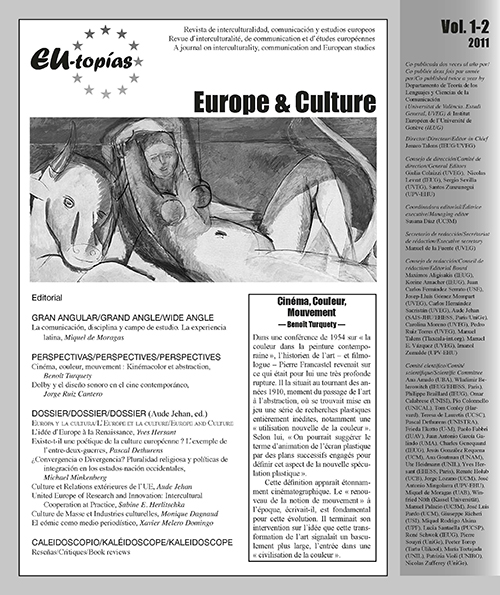Dolby and the design of sound in contemporary cinema
DOI:
https://doi.org/10.7203/eutopias.1.18438Keywords:
Dolby, conception sonore, son cinematographique, Nouveau Hollywood, Walter Murch, Ben Burtt Abstract
Abstract
For film sound, the last forty years has been a landmark for continuous improvement. A progress manifested not only at the technical or aesthetic levels, but also patent when looking at the increasing importance nowadays of the soundtrack in the process of designing and producing a movie. This article analyzes the decisive role played by Dolby technologies in all these transformations, and also outlines some ideas about the future evolution of the issue
 Downloads
Downloads
 References
References
BECK, Jay (2008). “The Sounds of ‘Silence’. Dolby Stereo, Sound Design, and The Silence of the Lambs”, en Jay Beck y Tony Grajeda (eds.), Lowering the Boom. Critical Studies in Film Sound, , pp. 68-83. Baltimore: University of Illionis Press.
CHION, Michel (1993). La audiovisión. Introducción a un análisis conjunto de la imagen y el sonido. Barcelona: Paidós.
Dolby (2010). “The Evolution of Dolby Film Sound” [En línea]. Disponible en <http://www.dolby.com/uploadedFiles/zz-_Shared_Assets/English_PDFs/ Professional/53_ EvolutionOfSound.pdf>. [Consultado 25 enero 2011].
HANDZO, Stephen (1985). “A Narrative Glossary on Film Sound Technology”, en Elisabeth Weis y John Belton (eds.), Film Sound, pp. 383-426. New York: Columbia University Press.
IOSONO (2010). “The Technology” [En línea]. Disponible en <http://www.iosono-sound. com>. [Consultado 20 enero 2011].
KASSAB, John (2009). “Report to investigate creative, technical and workflow innovations in post-production film sound in London, New York, San Francisco, Los Angeles and Wellington” [En línea]. Disponible en <http//www.churchilltrust.com.au/site_media/fellows/ 2009_Kassab_John.pdf>. [Consultado 20 enero 2011].
MANCINI, Marc (1985). “The Sound Designer”, en Elisabeth Weis y John Belton (eds.), Film Sound, pp. 361-368. New York: Columbia University Press. Publicado originariamente como «Sound Thinking» en Film Comment 19.6 (Noviembre- Diciembre 1983), pp. 40-43, 45-47.
MURCH, Walter (2000). “Stretching Sound to Help the Mind See” [En línea]. Disponible en <http://filmsound.org/murch/stretching.htm>. [Consultado 21 enero 2011].
MURCH, Walter (2007). “Touch of Silence”, en Larry Sider, Diane Freeman y Jerry Sider (eds.), Soundscape. The School of Sound Lectures 1998-2001, pp. 83-102. London: Wallflower Press.
PETROSKY, Max (2010). “Tron Wiki: Frank Serafine Interview” [En línea]. Disponible en <http://tron.wikia.com/ wiki/Tron_Wiki:Frank_Serafine_ Interview>. [Consultado 21 enero 2011].
SCHREGER, Charles (1985). “Altman, Dolby, and the Second Sound Revolution”, en Elisabeth Weis y John Belton (eds.), Film Sound, pp. 348-355. New York: Columbia University Press. Publicado originariamente en Film Comment, 14, nº 5 (Septiembre-Octubre 1978). Título original: “The Second Coming of Sound”.
SERGI, Gianluca (1999). “The Sonic Playground. Hollywood Cinema and its Listeners” [En línea]. Disponible en <http://www.filmsound.org/articles/sergi>. [Consultado 24 enero 2011].
SERGI, Gianluca (2004). The Dolby era. Film Sound in Contemporary Hollywood. Manchester & New York: Manchester University Press.
SHATZ, Leslie (2001): “The Dolby Film Sound Revolution: Looking Back and Looking Forward with Audio Pioneer Ioan Allen” [En línea]. Disponible en <http://www. editorsguild.com/v2/magazine/Newsletter/SepOct01/ioan_allen_one.html>. [Consultado 24 enero 2011]. Reimpreso de The Motion Picture Editors Guild Magazine. Vol. 22, No. 4 – September/October 2001.
TURNER, Nick, y Tom Giles, (eds.) (2010). “Pixar Gets Dolby to Invent ‘Rain of Sound’ to Match 3D Movies” [En línea]. Disponible en <http://www.sfgate.com/cgi-bin/ article.cgi?f=/g/a/2010/05/22/bloomberg1376-L2SL460YHQ0X-1.DTL>. [Consultado 12 junio 2010].
WHITTINGTON, William (2007). Sound Design and Science Fiction. Austin: University of Texas Press.
Downloads
Published
How to Cite
-
Abstract543
-
PDF (Español)404
Issue
Section
License
![]()
The authors conserve the copyright. All content published in EU-topías. Journal of interculturality, Communication, and European Studies are subject to the license Creative Commons Attribution-NonCommercial-ShareAlike 4.0 license. The full text of the license can be found at <http://creativecommons.org/licenses/by-nc-sa/4.0>
They may be copied, used, disseminated, transmitted and publicly displayed, provided that:
- The authorship and original source of the publication is cited (journal, publisher and URL of the work).
- They are not used for commercial purposes.
- The existence and specifications of this license of use are mentioned.
It is the responsibility of the authors to obtain the necessary permissions for images that are subject to copyright.



